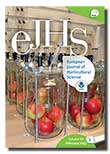

European Journal of Horticultural Science

Cold Hardiness and its Relationship with Proline Content in Persian Walnut
Authors
A. Aslani Aslamarz1) ; K. Vahdati1) ; D. Hassani2) ; M. Rahemi1) ; N. Mohammadi1) ; C. Leslie3)1)University of Tehran, Tehran, Iran; 2)Seed, Plant Improvement Institute (SPII), Karaj, Iran; 3)University of California, Davis, CA, USA
Summary
The study of cold hardiness is important because freeze injury is a leading cause of walnut yield losses in many cold regions of Europe and Asia. In this study, three methods of determining cold acclimation in walnut cultivars/genotypes were compared: 1) electrolyte leakage measurement (EL); 2) triphenyl tetrazolium chloride assay (TTC) and; 3) proline analysis. Stems of eight walnut cultivars and genotypes were cut and collected every month from November 2007 to April 2008. EL was conducted using uniform pieces inserted into plastic vials programmed to decrease their temperature by 2 °C h-1 to freezing temperatures of -5, -10,-15, -20, -25 and -30 °C. The electrolyte leakage from frozen stem tissues was captured in solution and measured using an electrical conductivity meter. Tissue injury was also assessed by TTC analysis using stem segments cooled under controlled temperatures at 2 °C h-1 to set temperatures ranging from 5 to -30 °C and results were quantified using a spectrophotometer. Proline content of fresh stem tissues was determined using the Bates method. Cold hardiness of samples increased with accumulated seasonal chilling and decreased as they approached spring bud break. A 1.4 to 2.7 fold increase in proline content was observed in stems from November to midwinter. LT50s (temperature causing 50 % lethal injury) ranged from -5.8 to -10 °C in November, -12.5 to -19.3 °C in midwinter and -5.8 to -9.2 °C in early spring. Using both the EL and TTC methods, cultivars and genotypes were classified into three groups based on their cold hardiness: sensitive (‘Z30’ and 'Serr' ), semi-hardy (‘Z53’, ‘Z67’, and 'Hartley' ) and hardy ( 'Lara' , ‘Z63’ and 'Pedro' ).
Download full-text version (PDF 480760 bytes)
Keywords
cold hardy; frost injury; ion leakage; proline; temperature
